Article Contents
Introduction
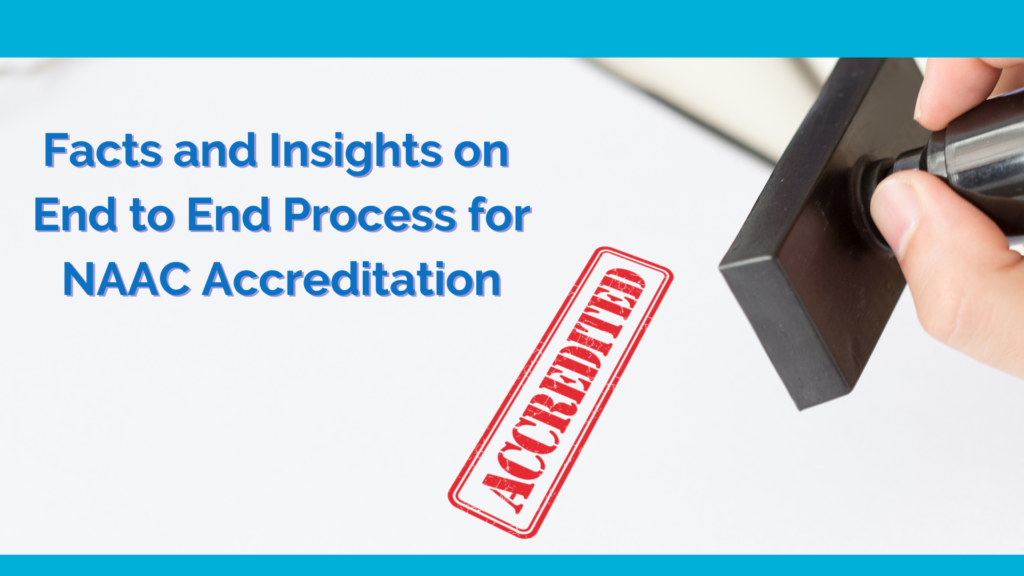
Getting an accreditation from an authorized body is a requisite for every educational institution. Accreditation ascertains the characteristics and quality of education an institution offers. It helps the students accelerate the growth of their personal development and career.
Employers and recruiters are more inclined toward setting up campus placement drives with accredited educational entities. Nevertheless, accredited institutes and commodities are the first to be considered a source of top-notch students with insightful knowledge.
In a nutshell, accreditation adds to the value of the education and qualifications the students have endured and determines the “quality assessment” of educational institutions. One such glorified and well-renowned “quality check” is the NAAC accreditation.
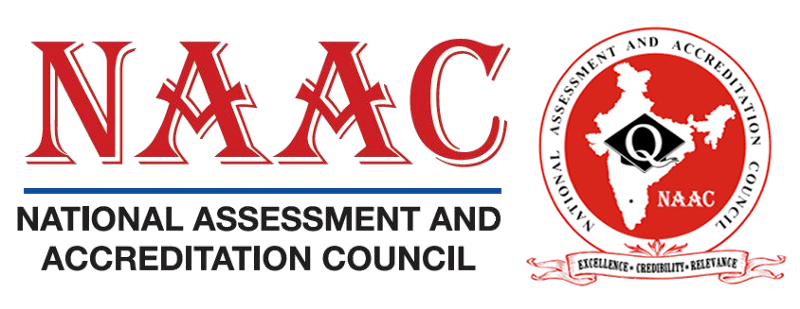
NAAC is a form of quality assurance approval for educational institutions.
Intent and role of NAAC accreditation
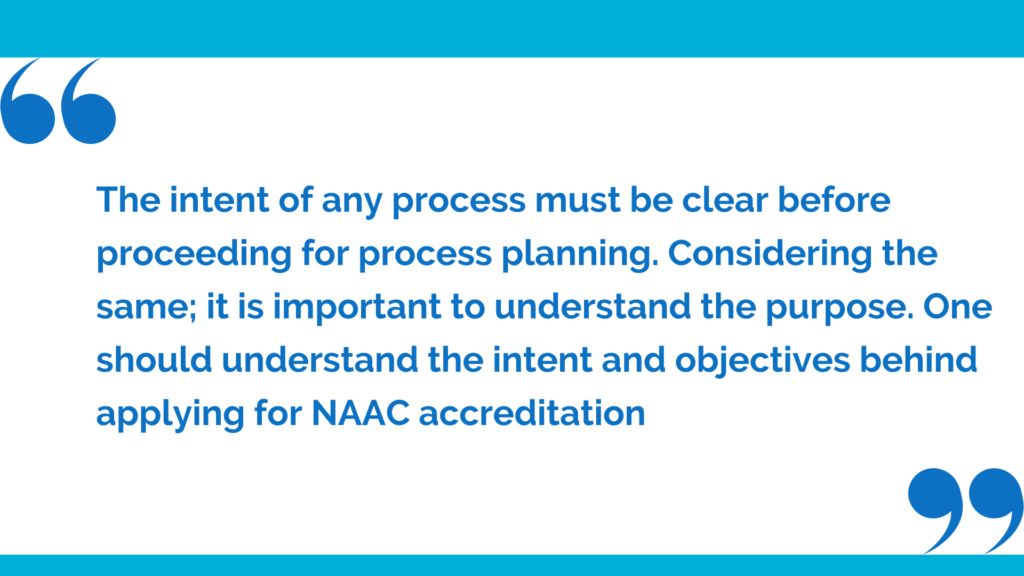
NAAC certification intends to establish a sound and fair standard for quality education within educational bodies, primary or higher. Every educational entity that wants to get certified with NAAC accreditation has to adhere to a set of rules drafted by the NAAC council.
Another good reason for educational entities to have NAAC accreditation is what makes them eligible to reap the benefits of raising funds from the state and federal governments.
Education is the apex pillar of a nation’s development and growth. That is all the more reason why the merit and application of the courses and programs provided by higher educational institutions need to have the optimum degree of quality and standard.

Every business has a unique way of enhancing the grade with an out-of-the-box capacity for standards. Every educational body must try and zero in to figure out the requisites to fulfil the set of measures per the global standards of NAAC.
The prime role and function of the NAAC accreditation are to acquire the best in every establishment and assist foundations with development across research, advancement, student achievement, administration, and more. Are you going forward to submit a NAAC accreditation?, here is how the technology can help you in getting better rating.
Here are the step-by-step details of the NAAC accreditation process
The NAAC Accreditation Process
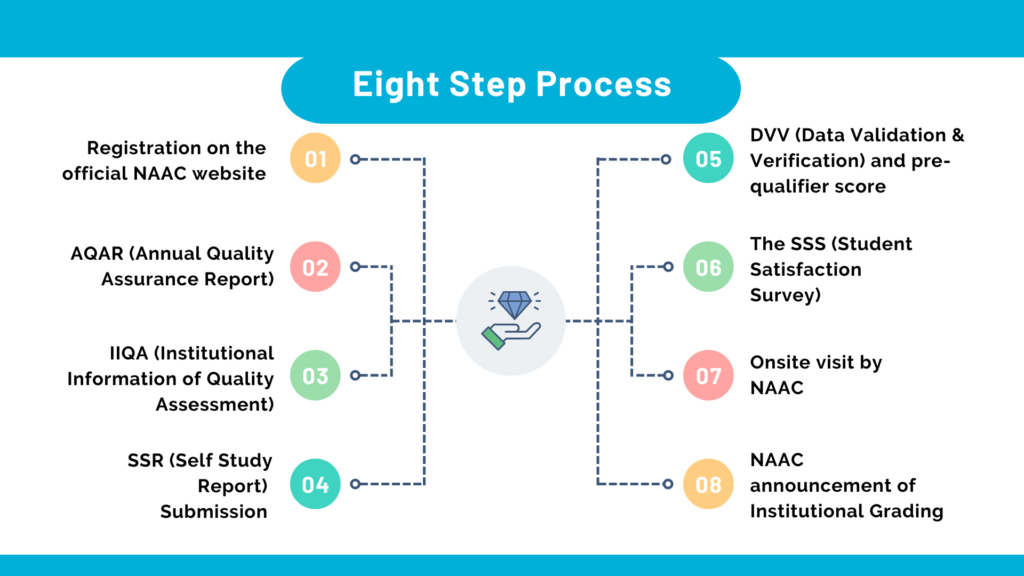
The UGC (University Grants Commission) has mandated NAAC by 2022. It shows the spotlight NAAC is in as of late. NAAC accreditation is the qualified benchmark for higher education institution entities. Hence NAAC has put up a standardized procedure along with a self-study report that boils down to gaining excellence for institutions.
When an education body becomes NAAC-eligible, it is a clear sign that it is shaping up to provide quality education and craft a better tomorrow for the nation.
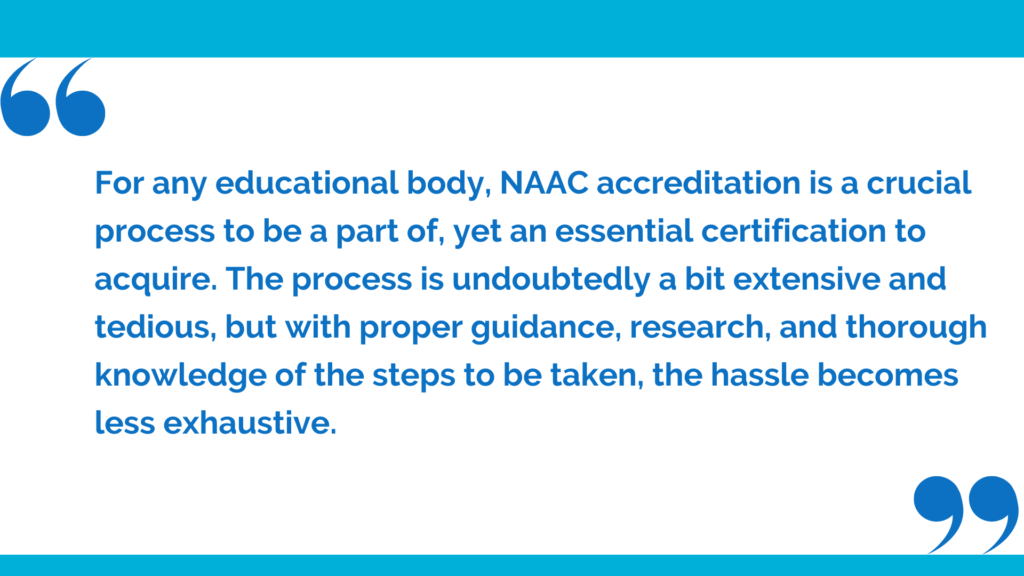
On a more extensive level, the NAAC rounds off its certification in three levels:
- IIQA (Institutional Information of Quality Assessment) and SSR (Self Study Report)
- DVV (Data Validation and Verification) and SSS (Student Satisfaction Survey)
- Onsite assessment, expert examination by specialed visiting teams
To make the process easily digestible, we have broken down the three-step process into eight elaborate steps.
- Registration on the official NAAC website
- AQAR (Annual Quality Assurance Report)
- IIQA (Institutional Information of Quality Assessment)
- SSR submission
- DVV (Data Validation & Verification) and pre-qualifier score
- SSS (Student Satisfaction Survey)
- Onsite visit by NAAC
- NAAC Announcement of Institutional Grading

1. Registration on the official NAAC website– To proceed with registration with NAAC, the very first step is to create a profile for your institute, here is how to start
The process for NAAC Accreditation initiates with the HEIs (Higher Education Institutions) registering themselves on the official website of NAAC. Initially, the institution has to fill out the registration form with an AISHE(All India Survey on Higher Education) reference code.
It is known as profile generation for educational bodies. The educational institution may or may not be affiliated, autonomous, private, or deemed a University; the registration is compulsory for one and all.
It is a must for an educational body to have an AISHE code before applying for A&A (Assessment and Accreditation). The institutions also have to present a self-declaration of their current affiliation status. Upon the registration form being filled out, it is verified and validated by the NAAC. After validation, login credentials are provided to the HEIs, which enable them to access the official portal NAAC.
2. What is AQAR? What is its role in NAAC accreditation?
The AQAR (Annual Quality Assurance Report) is an annual report that has to be presented to the NAAC body online every year by all the acknowledged institutions according to the standardized format. The AQAR is a crucial report that provides deep insights into the institutions’ overall growth in all seven identified criteria of the NAAC. It additionally presents data in a systematic format about the various developments taken up by the educational body.
In the previous format, the AQAR submission through email would close in December. The HEIs presented their AQAR through the NAAC web portal. As per the new rules, educational bodies accredited before 2017 should re-register themselves for accreditation on the NAAC portal. It is essential to know that once you submit the AQAR details through the official NAAC portal, no further allowed.
3. IIQA (Institutional Information of Quality Assessment) in the NAAC accreditation process
The next step is the submission of the IIQA. In this step, the educational body has to log in to the official NAAC portal and fill out the IIQA form beside the fees for the application. There are plenty of documents that the entity has to submit adhering to the standard set of formats. Here is the list of documents to be submitted for IIQA:
For Colleges:
- Affiliating University letter(s) for the current academic year for all the programs offered by the HEI.
- Current academic year recognition/approval letter from Statutory Regulatory Authority (SRA) like AICTE, MCI, BCI, PCI, etc… if applicable.
- UGC 2f and 12(B) recognition certificates and the latest Plan /General Development Grant release letter from UGC (if applicable).
- Colleges with CPE / CE Status – Letter from UGC awarding CPE / CE Status.
- Autonomous Colleges- Letter from UGC conferring Autonomous Status.
- Latest AISHE certificate or provide the relevant message indicating the DCF no. as proof of uploading data on the All India Survey on Higher Education (AISHE) portal.
- If there is a name change, submit approval of the affiliating University indicating the change.
- SRA or other governmental agencies’ approval for standalone institutions.
- Standalone institutions should submit equivalence certificates (UG/PG) from AIU or other governmental agencies.
- Standalone institutions should submit their SSR using an autonomous manual.
- Upload AQARs on the website and provide URL details in IIQA (applicable for institutions applying for Cycle 2 and subsequent cycles).
- Undertaking by the HEIs complying with rules and regulations of the Central Government, State Government, UGC, Affiliating University, and other applicable SRA in the format provided by NAAC.
- Self-declaration concerning Affiliation status in the format provided by NAAC.
For Universities:
- Approval of UGC/MHRD/State government for the establishment of the University
- Current academic year recognition/approval letter from Statutory Regulatory Authority (SRA) like AICTE, MCI, BCI, PCI, etc… if applicable.
- UGC 2f and 12(B) recognition certificates and the latest Plan /General Development Grant release letter from UGC (if applicable).
- UPE status – Letter from UGC regarding the award of UPE status
- AISHE certificate as proof of data submission on the All India Survey on Higher Education (AISHE) portal.
- If there is a name change, submit approval of the appropriate Government agencies, MHRD/ UGC /SRA indicating the change.
- Upload AQARs to the website and provide URL details (applicable for institutions applying for Cycle 2 and subsequent cycles).
- Undertaking by the HEIs complying with rules and regulations of the Central Government, State Government, UGC, and other applicable SRA in the format provided by NAAC.
According to the RAF(Revised Accreditation Framework), the IIQA operates at two intervals per year. The 1st interval is May June, and the second is November-December. The HEIs have to submit their applications during the specified interval of a year. It takes approximately 15 days for NAAC to verify the details submitted and announce the eligibility of HEIs for accreditation.
4. SSR submission as part of NAAC
The next step is to prepare the SSR(Self Study Report) for the educational body. After receiving the IIQA approval from the NAAC, educational bodies must fill in the SSR form and upload all the requested documents through the official NAAC portal.
- Preface or Cover Letter from the Head of the Institution
- Executive Summary – The ‘Strengths, Weaknesses, Opportunities and Constraints’ (SWOC) analysis of the institution
- Profile of the Institution
- Criteria-wise report –The institution should provide a consolidated response for each of the prime aspects with the Quality Indicators Framework (QIF) comprising Data Templates/Documents (Quantitative and Qualitative)
- Illustrative Report of Departments (University and Autonomous College)
SSR submission includes both Qualitative and Quantitative metrics. Wherein, Qualitative Metrics require descriptive details on the said parameters, and Quantitative Metrics focus on quantifiable facts and figures. The NAAC portal has enabled an online mode of payment for educational bodies to pay the application fees, which are Rs. 25000/- plus taxes.
Institutes should pay the fees in two instalments. The first 50% goes with the SSR report submission, and the remaining c before 15 days of the actual NAAC visit. An important thing to note here is that the application fees are non-refundable.
After successful application submission, the education body receives an auto-generated Link/ID on their registered email. The institute should then consider uploading the SSR in PDF format on its website.

5. DVV (Data validation and verification) and pre-qualifier score
DVV(Data Validation & Verification) is the next step where the educational bodies could use some rest while NAAC verifies and validates the details submitted through the SSR submissions.
Here’s the list of data required for the DVV process:
- List of programs (conducted in the last five years)
- Self-study report (SSR report)
- Evidence of data
- Documents and Records Compliance MIS Reports
- E-Copies of Awards/Recognition Feedback from Students Circulars of Initiatives/New Implementation
After verifying and validating the presented data, NAAC generates a pre-qualified score using an online mechanism. DVV is a conclusive process. It is responsible for scrutinizing the shortcomings and drop-offs in the data shared by the educational bodies.
On submitting incorrect data, educational bodies may receive a clarification notice asking for the deviation report on the specific parameters. If the education body fails to present the justification for the false data or is found to have done that on purpose, it will be debarred from the registration and is liable for legal action by NAAC.
There is not any set timeline for the DVV process, but whilst the DVV clarification is ongoing, the institutions are supposed to present with a clarification in a specified time. Ultimately, NAAC will re-evaluate the details submitted and verify the data deviations to settle on a pre-qualifier score.
The minimum set score for the pre-qualifier of SSR is 30%. In the end, if the education body scores less than 30%, it will have to re-apply for the entire process from scratch. And, there is one condition: the educational body will be eligible to re-apply after six months from the declaration date of the pre-qualification score.
Hence, relying upon the DVV score, NAAC will decide:
- Peer Team visit dates
- Peer team visit deferring
- Peer team Visit disqualification
As a PTV (Peer Team Visit) process, the NAAC body decides the visitation dates with the visiting teams within three- weeks of SSR submission.
6. The SSS (Student Satisfaction Survey)
The Student Satisfaction Survey (SSS) executes parallel with the DVV process. NAAC appreciates the involvement of all the stakeholders associated with the educational body, from the management, HODs, Faculty members, Administrative Staff, Employee Community, Alumni, and Students. The student group is a crucial participant at this stage as they are the prime source of the quality of education provided.
The SSS (Student Satisfaction Survey) aims to engage the students in the quality conviction procedure. For the CGPA calculations, the SSS score is an indomitable parameter. The education body has to present end-to-end student records consisting of admission details, program details, contact details, and more specified details for the SSS submissions.
7. Onsite visit by NAAC
The onsite assessment is one of the most crucial steps in NAAC accreditation. The onsite assessment team evaluates all the information and data presented for the qualitative and quantitative metrics. The team includes researchers, senior administrators, and distinguished academicians from the educational domain.
They take an Assessors Orientation Programme for the assessors to be eligible for the Peer Team membership. NAAC’s qualitative and quantitative metrics have been distributed in a proportion of 1/3rd and 2/3rd, respectively. Educational bodies are mandated to upload their data in the formats above.
8. NAAC announcement of Institutional Grading
It’s the final step of the A&A process where the NAAC body announces the grades for the educational body.
After the onsite visit, the NAAC team generates a Qualitative Report based on the parameters such as strengths, challenges, weaknesses, and opportunities.
Eventually, the NAAC body combines all the below-mentioned scores for the CrGPA (Criterion-wise Grade Point Averages):
- Qualitative Metrics for the Statistical Analysis
- NAAC assessment team report
- The Institution’s Grading Sheet (Qualitative Indicators, Quantitative Indicators, and Student Satisfaction Survey.
The NAAC’s Executive Council reviews the final consolidated report for accreditation approval. On approval by the council, the educational body gets to hear about the accreditation status and the NAAC grade obtained.
Moving ahead, you should learn from the experiences of others, here are the most common mistakes institutes make while applying for NAAC accreditation.


